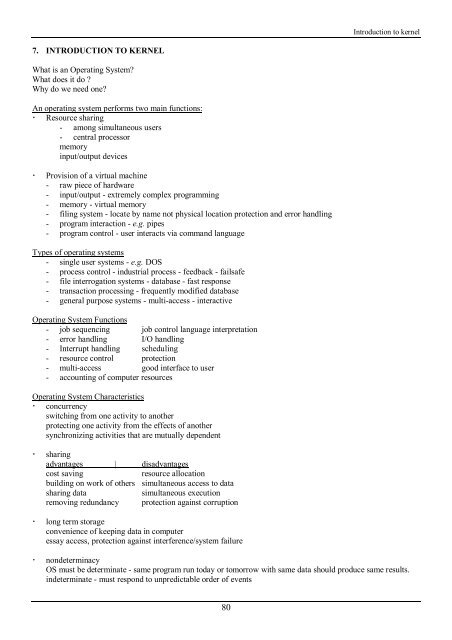You also want an ePaper? Increase the reach of your titles
YUMPU automatically turns print PDFs into web optimized ePapers that Google loves.
Introduction to kernel<br />
7. INTRODUCTION TO KERNEL<br />
What is an Operating System?<br />
What does it do ?<br />
Why do we need one?<br />
An operating system performs two main functions:<br />
! Resource sharing<br />
- among simultaneous users<br />
- central processor<br />
memory<br />
input/output devices<br />
! Provision of a virtual machine<br />
- raw piece of hardware<br />
- input/output - extremely complex programming<br />
- memory - virtual memory<br />
- filing system - locate by name not physical location protection and error handling<br />
- program interaction - e.g. pipes<br />
- program control - user interacts via command language<br />
Types of operating systems<br />
- single user systems - e.g. D<strong>OS</strong><br />
- process control - industrial process - feedback - failsafe<br />
- file interrogation systems - database - fast response<br />
- transaction processing - frequently modified database<br />
- general purpose systems - multi-access - interactive<br />
Operating System Functions<br />
- job sequencing job control language interpretation<br />
- error handling I/O handling<br />
- Interrupt handling scheduling<br />
- resource control protection<br />
- multi-access good interface to user<br />
- accounting of computer resources<br />
Operating System Characteristics<br />
! concurrency<br />
switching from one activity to ano<strong>the</strong>r<br />
protecting one activity from <strong>the</strong> effects of ano<strong>the</strong>r<br />
synchronizing activities that are mutually dependent<br />
! sharing<br />
advantages | disadvantages<br />
cost saving<br />
resource allocation<br />
building on work of o<strong>the</strong>rs simultaneous access to data<br />
sharing data<br />
simultaneous execution<br />
removing redundancy protection against corruption<br />
! long term storage<br />
convenience of keeping data in computer<br />
essay access, protection against interference/system failure<br />
! nondeterminacy<br />
<strong>OS</strong> must be determinate - same program run today or tomorrow <strong>with</strong> same data should produce same results.<br />
indeterminate - must respond to unpredictable order of events<br />
80
















